英语系动词详解
- 格式:doc
- 大小:59.50 KB
- 文档页数:14

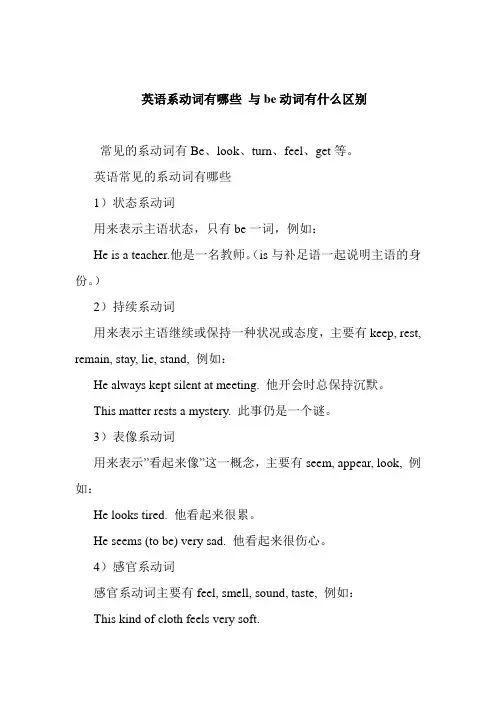
英语系动词有哪些与be动词有什么区别常见的系动词有Be、look、turn、feel、get等。
英语常见的系动词有哪些1)状态系动词用来表示主语状态,只有be一词,例如:He is a teacher.他是一名教师。
(is与补足语一起说明主语的身份。
)2)持续系动词用来表示主语继续或保持一种状况或态度,主要有keep, rest, remain, stay, lie, stand, 例如:He always kept silent at meeting. 他开会时总保持沉默。
This matter rests a mystery. 此事仍是一个谜。
3)表像系动词用来表示”看起来像”这一概念,主要有seem, appear, look, 例如:He looks tired. 他看起来很累。
He seems (to be) very sad. 他看起来很伤心。
4)感官系动词感官系动词主要有feel, smell, sound, taste, 例如:This kind of cloth feels very soft.这种布手感很软。
This flower smells very sweet.这朵花闻起来很香。
5)变化系动词这些系动词表示主语变成什么样,变化系动词主要有become, grow, turn, fall, get, go, come, run.例如:He became mad after that. 自那之后,他疯了。
She grew rich within a short time. 她没多长时间就富了。
6)终止系动词表示主语已终止动作,主要有prove, trun out, 表达”证实”,”变成”之意,例如:The rumor proved false.这谣言证实有假。
The search proved difficult.搜查证实很难。
His plan turned out a success. 他的计划终于成功了。
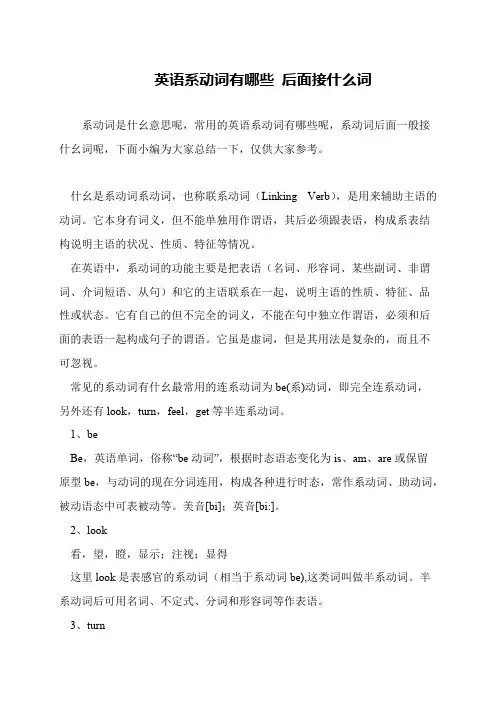
英语系动词有哪些后面接什么词
系动词是什幺意思呢,常用的英语系动词有哪些呢,系动词后面一般接
什幺词呢,下面小编为大家总结一下,仅供大家参考。
什幺是系动词系动词,也称联系动词(Linking Verb),是用来辅助主语的动词。
它本身有词义,但不能单独用作谓语,其后必须跟表语,构成系表结
构说明主语的状况、性质、特征等情况。
在英语中,系动词的功能主要是把表语(名词、形容词、某些副词、非谓词、介词短语、从句)和它的主语联系在一起,说明主语的性质、特征、品
性或状态。
它有自己的但不完全的词义,不能在句中独立作谓语,必须和后
面的表语一起构成句子的谓语。
它虽是虚词,但是其用法是复杂的,而且不
可忽视。
常见的系动词有什幺最常用的连系动词为be(系)动词,即完全连系动词,
另外还有look,turn,feel,get等半连系动词。
1、be
Be,英语单词,俗称“be动词”,根据时态语态变化为is、am、are或保留
原型be,与动词的现在分词连用,构成各种进行时态,常作系动词、助动词,被动语态中可表被动等。
美音[bi];英音[bi:]。
2、look
看,望,瞪,显示;注视;显得
这里look是表感官的系动词(相当于系动词be),这类词叫做半系动词。
半
系动词后可用名词、不定式、分词和形容词等作表语。
3、turn。

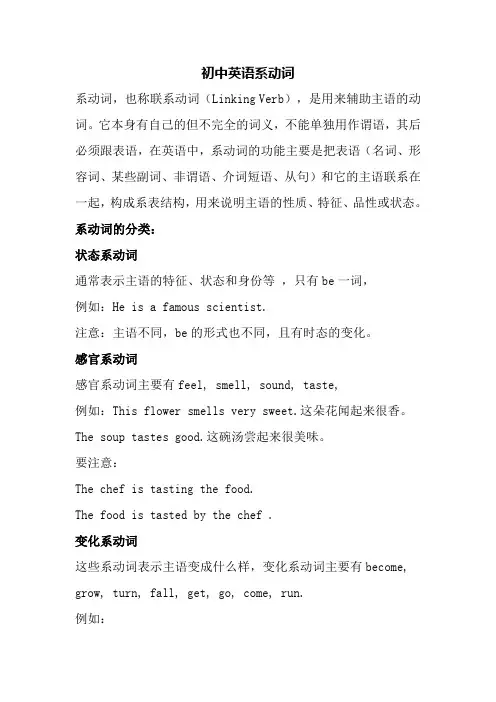
初中英语系动词系动词,也称联系动词(Linking Verb),是用来辅助主语的动词。
它本身有自己的但不完全的词义,不能单独用作谓语,其后必须跟表语,在英语中,系动词的功能主要是把表语(名词、形容词、某些副词、非谓语、介词短语、从句)和它的主语联系在一起,构成系表结构,用来说明主语的性质、特征、品性或状态。
系动词的分类:状态系动词通常表示主语的特征、状态和身份等,只有be一词,例如:He is a famous scientist.注意:主语不同,be的形式也不同,且有时态的变化。
感官系动词感官系动词主要有feel, smell, sound, taste,例如:This flower smells very sweet.这朵花闻起来很香。
The soup tastes good.这碗汤尝起来很美味。
要注意:The chef is tasting the food.The food is tasted by the chef .变化系动词这些系动词表示主语变成什么样,变化系动词主要有become, grow, turn, fall, get, go, come, run.例如:He became mad after that.自那之后,他疯了。
She grew rich within a short time.她没多长时间就富了一般情况下,系动词没有进行时态,但是这些表示变化类的系动词,是可以用进行时态的,例如It was becoming cold, so we lit the fire.天气变冷了,所以我们点起了火另外某些含有变化意义的动态系动词如get, become, grow, turn等的进行时态可与形容词的比较级连用,表示渐进过程,其意思是“越来越……”。
Our life is becoming better and better.持续系动词用来表示主语继续或保持一种状况或态度,主要有keep, remain, stay, lie, stand, 例如:He always keeps silent at meeting.他开会时总保持沉默。
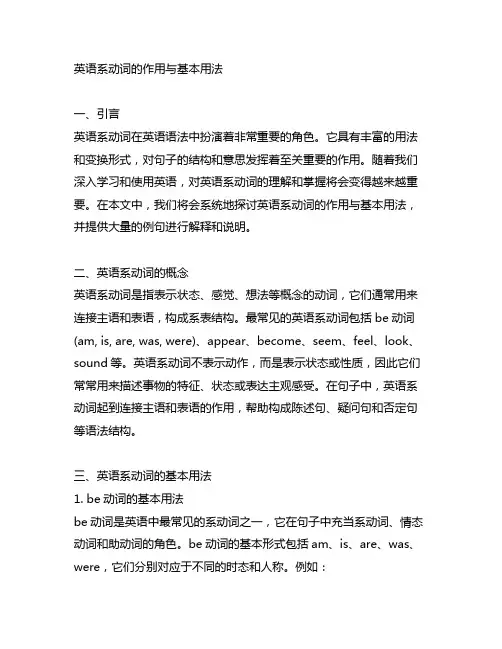
英语系动词的作用与基本用法一、引言英语系动词在英语语法中扮演着非常重要的角色。
它具有丰富的用法和变换形式,对句子的结构和意思发挥着至关重要的作用。
随着我们深入学习和使用英语,对英语系动词的理解和掌握将会变得越来越重要。
在本文中,我们将会系统地探讨英语系动词的作用与基本用法,并提供大量的例句进行解释和说明。
二、英语系动词的概念英语系动词是指表示状态、感觉、想法等概念的动词,它们通常用来连接主语和表语,构成系表结构。
最常见的英语系动词包括be动词(am, is, are, was, were)、appear、become、seem、feel、look、sound等。
英语系动词不表示动作,而是表示状态或性质,因此它们常常用来描述事物的特征、状态或表达主观感受。
在句子中,英语系动词起到连接主语和表语的作用,帮助构成陈述句、疑问句和否定句等语法结构。
三、英语系动词的基本用法1. be动词的基本用法be动词是英语中最常见的系动词之一,它在句子中充当系动词、情态动词和助动词的角色。
be动词的基本形式包括am、is、are、was、were,它们分别对应于不同的时态和人称。
例如:- She is a teacher. (她是一名老师)- They were happy. (他们很快乐)2. appear、become、seem等系动词的基本用法除了be动词之外,英语中还有许多其他系动词,它们在句子中同样起到连接主语和表语的作用。
这些系动词包括appear(出现)、become(变成)、seem(似乎)等,它们通常用来描述事物的状态、变化或表达人的感受。
例如:- The sun appears bright. (太阳看起来很明亮)- She became a doctor. (她成为了一名医生)- He seems tired. (他看起来很累)四、英语系动词的深度解析在实际运用中,英语系动词的用法非常灵活多样,需要根据具体的语境和情境来进行准确的选择和搭配。
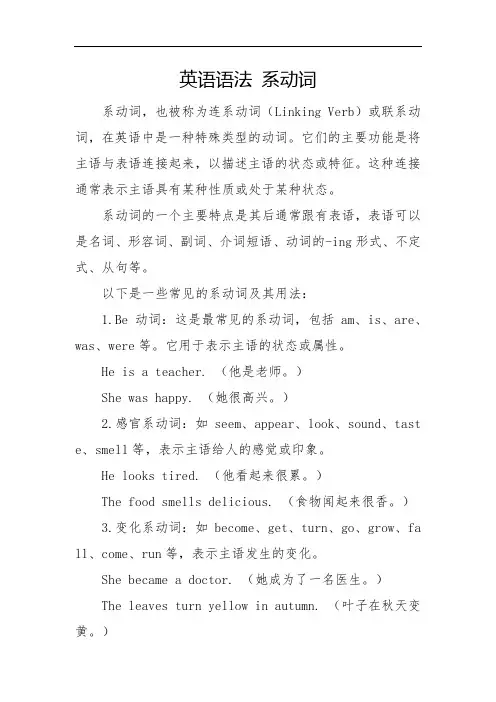
英语语法系动词系动词,也被称为连系动词(Linking Verb)或联系动词,在英语中是一种特殊类型的动词。
它们的主要功能是将主语与表语连接起来,以描述主语的状态或特征。
这种连接通常表示主语具有某种性质或处于某种状态。
系动词的一个主要特点是其后通常跟有表语,表语可以是名词、形容词、副词、介词短语、动词的-ing形式、不定式、从句等。
以下是一些常见的系动词及其用法:1.Be动词:这是最常见的系动词,包括am、is、are、was、were等。
它用于表示主语的状态或属性。
He is a teacher. (他是老师。
)She was happy. (她很高兴。
)2.感官系动词:如seem、appear、look、sound、taste、smell等,表示主语给人的感觉或印象。
He looks tired. (他看起来很累。
)The food smells delicious. (食物闻起来很香。
)3.变化系动词:如become、get、turn、go、grow、fa ll、come、run等,表示主语发生的变化。
She became a doctor. (她成为了一名医生。
)The leaves turn yellow in autumn. (叶子在秋天变黄。
)4.持续系动词:如keep、stay、remain、lie、stand 等,表示主语保持某种状态。
The weather remains sunny. (天气仍然晴朗。
)She always keeps silent. (她总是保持沉默。
)5.其他系动词:如seem、appear、prove、turn out等,这些系动词通常用于表示主语的某种性质或状态。
The report proves true. (报告证明是真的。
)It turned out to be a lie. (事实证明那是个谎言。
)在使用系动词时,要注意它们通常与表语连用,以描述主语的状态或属性。
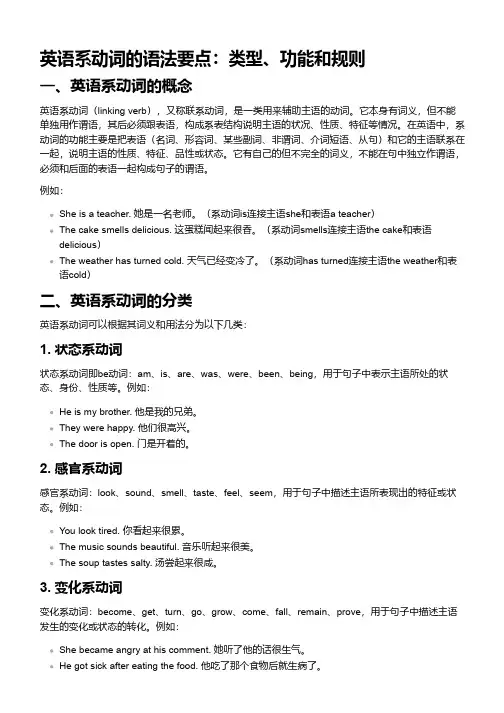
英语系动词的语法要点:类型、功能和规则一、英语系动词的概念英语系动词(linking verb),又称联系动词,是一类用来辅助主语的动词。
它本身有词义,但不能单独用作谓语,其后必须跟表语,构成系表结构说明主语的状况、性质、特征等情况。
在英语中,系动词的功能主要是把表语(名词、形容词、某些副词、非谓词、介词短语、从句)和它的主语联系在一起,说明主语的性质、特征、品性或状态。
它有自己的但不完全的词义,不能在句中独立作谓语,必须和后面的表语一起构成句子的谓语。
例如:She is a teacher. 她是一名老师。
(系动词is连接主语she和表语a teacher)The cake smells delicious. 这蛋糕闻起来很香。
(系动词smells连接主语the cake和表语delicious)The weather has turned cold. 天气已经变冷了。
(系动词has turned连接主语the weather和表语cold)二、英语系动词的分类英语系动词可以根据其词义和用法分为以下几类:1. 状态系动词状态系动词即be动词:am、is、are、was、were、been、being,用于句子中表示主语所处的状态、身份、性质等。
例如:He is my brother. 他是我的兄弟。
They were happy. 他们很高兴。
The door is open. 门是开着的。
2. 感官系动词感官系动词:look、sound、smell、taste、feel、seem,用于句子中描述主语所表现出的特征或状态。
例如:You look tired. 你看起来很累。
The music sounds beautiful. 音乐听起来很美。
The soup tastes salty. 汤尝起来很咸。
3. 变化系动词变化系动词:become、get、turn、go、grow、come、fall、remain、prove,用于句子中描述主语发生的变化或状态的转化。
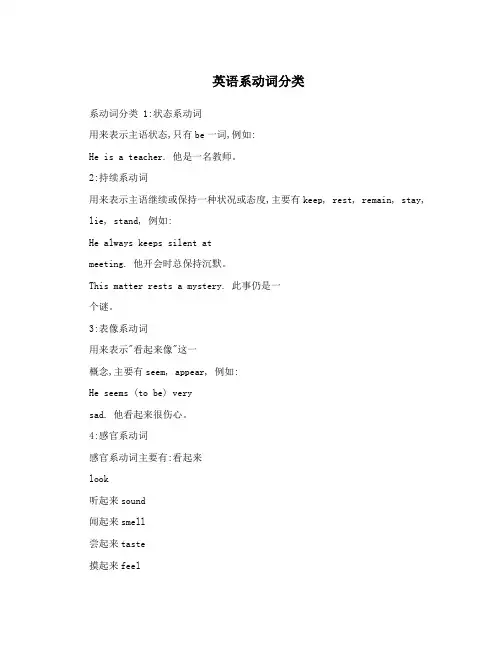
英语系动词分类系动词分类 1:状态系动词用来表示主语状态,只有be一词,例如:He is a teacher. 他是一名教师。
2:持续系动词用来表示主语继续或保持一种状况或态度,主要有keep, rest, remain, stay, lie, stand, 例如:He always keeps silent atmeeting. 他开会时总保持沉默。
This matter rests a mystery. 此事仍是一个谜。
3:表像系动词用来表示"看起来像"这一概念,主要有seem, appear, 例如:He seems (to be) verysad. 他看起来很伤心。
4:感官系动词感官系动词主要有:看起来look听起来sound闻起来smell尝起来taste摸起来feel搭配: (1)+形容词:不用副词:(2)like+名词eg.1.Bill said that the mixturetasted__________(terrible, terribly).2.The doctor said tha t the baby didn’t look___________(healthy, healthily).3.The gas from the bottle smelledvery___________(strange, strangely).4.This kind of cloth feelsquite__________(soft, softly).5.Your ideasounds______________(nice, nicely). 例如:5:变化系动词这些系动词表示主语变成什么样,变化系动词主要有become, grow, turn, fall, get, go, come, run. 例如:He became madafter that. 自那之后,他疯了。
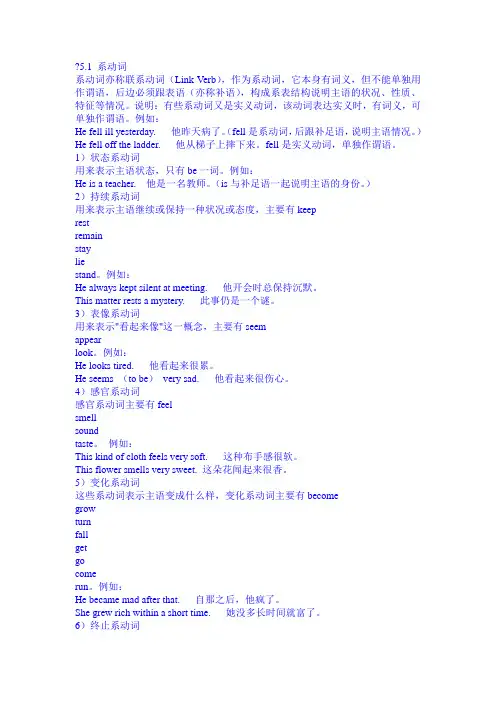
?5.1 系动词系动词亦称联系动词(Link Verb),作为系动词,它本身有词义,但不能单独用作谓语,后边必须跟表语(亦称补语),构成系表结构说明主语的状况、性质、特征等情况。
说明:有些系动词又是实义动词,该动词表达实义时,有词义,可单独作谓语。
例如:He fell ill yesterday.他昨天病了。
(fell是系动词,后跟补足语,说明主语情况。
)He fell off the ladder.他从梯子上摔下来。
fell是实义动词,单独作谓语。
1)状态系动词用来表示主语状态,只有be一词。
例如:He is a teacher.他是一名教师。
(is与补足语一起说明主语的身份。
)2)持续系动词用来表示主语继续或保持一种状况或态度,主要有keeprestremainstayliestand。
例如:He always kept silent at meeting.他开会时总保持沉默。
This matter rests a mystery.此事仍是一个谜。
3)表像系动词用来表示"看起来像"这一概念,主要有seemappearlook。
例如:He looks tired.他看起来很累。
He seems (to be)very sad.他看起来很伤心。
4)感官系动词感官系动词主要有feelsmellsoundtaste。
例如:This kind of cloth feels very soft.这种布手感很软。
This flower smells very sweet. 这朵花闻起来很香。
5)变化系动词这些系动词表示主语变成什么样,变化系动词主要有becomegrowturnfallgetgocomerun。
例如:He became mad after that.自那之后,他疯了。
She grew rich within a short time.她没多长时间就富了。
6)终止系动词表示主语已终止动作,主要有proveturn out表达"证实","变成"之意。
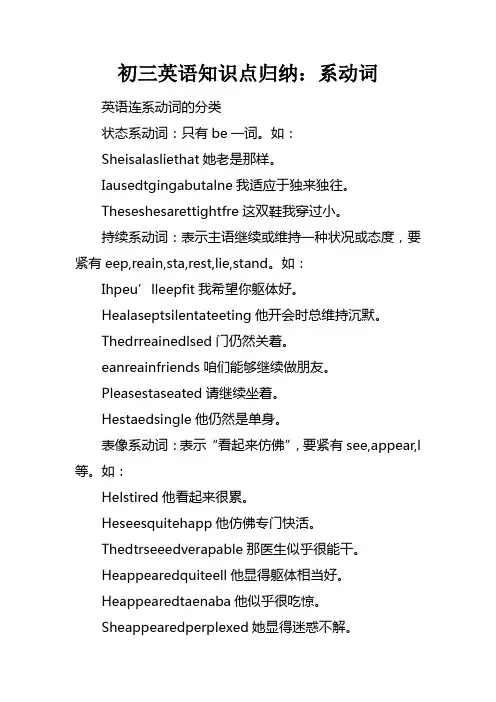
初三英语知识点归纳:系动词英语连系动词的分类状态系动词:只有be一词。
如:Sheisalasliethat她老是那样。
Iausedtgingabutalne我适应于独来独往。
Theseshesarettightfre这双鞋我穿过小。
持续系动词:表示主语继续或维持一种状况或态度,要紧有eep,reain,sta,rest,lie,stand。
如:Ihpeu’lleepfit我希望你躯体好。
Healaseptsilentateeting他开会时总维持沉默。
Thedrreainedlsed门仍然关着。
eanreainfriends咱们能够继续做朋友。
Pleasestaseated请继续坐着。
Hestaedsingle他仍然是单身。
表像系动词:表示“看起来仿佛”,要紧有see,appear,l 等。
如:Helstired他看起来很累。
Heseesquitehapp他仿佛专门快活。
Thedtrseeedverapable那医生似乎很能干。
Heappearedquiteell他显得躯体相当好。
Heappearedtaenaba他似乎很吃惊。
Sheappearedperplexed她显得迷惑不解。
感官系动词:表示“……起来”,有feel,sell,sund,taste 等。
如:Thisindflthfeelsversft这种布摸起来很软。
Helshnest,butatuallhe’sargue他看起来很老实,实际他是一个坏蛋。
Thealllaliete他们的样子我看起来都一样。
Everbdfeelsntented每一个人都感到很知足。
Iefeelsld冰感觉起来是凉的。
Silfeelssftandsth丝绸摸起来很柔软滑腻。
Itsundsagdidea这听起来是个好主意。
Thisfdtastesgd这菜好吃。
转变系动词:表示主语变成什么样,要紧有bee,gr,turn,fall,get,g,e,run如:Hebeaeadafterthat自那以后,他疯了。
第二课is/ am / are一、is/ am/ are是be动词,放在不同的位置,功能不同。
1、放在主语后面,充当的是谓语,就是所谓的系动词。
For example(举给例子):She is my mother.她是我的妈妈。
This is a ruler.这是一个尺子。
I am a student. 我是一名学生。
We are good friends.我们是好朋友。
You are a beautiful girl.你是一个漂亮的女孩儿。
2、放在主语后面,同时后面接现在分词或过去分词,主语+be doing或主语+be done形式时,be 动词就是助动词。
For example(举给例子):They are having a meeting.他们正在开会。
The work can b e done today.这项工作可以在今天完成。
二、is am are的用法和区别我(I)用am,你(you)用are,is连着他(he)她(she)它(it)三、Exercises1、This ( ) my book.A.isB.amC. areD. all2、I ()a boy.A.isB.amC. areD. all3、These ( ) the people who help us.A.isB.amC. areD. all4、What ( ) you doing?A.isB.amC. areD. all5、Hearts ( ) trumps(王牌)。
A.isB.amC. areD. all6、He () the man of all o thers for th e job。
A.isB.amC. areD. all7、What!() that true?A.isB.amC. areD. all答案(answer):1、A2、B3、C4、C5、C6、A7、A。
英语中系动词的概念系动词是英语中一类非常重要的动词,它们在句子中起到连接主语和表语的作用。
系动词的主要功能是表达主语的状态、性质、特征或身份等,而不是表示具体的动作或行为。
系动词通常可以分为以下几类:1. 状态系动词:这类系动词用于描述主语的状态或情况,常见的有 be(是), seem (似乎), appear(显得), look(看起来), feel(感觉), sound(听起来), taste (尝起来), smell(闻起来)等。
例如:He is a doctor. (他是一名医生。
)2. 持续系动词:这类系动词表示主语持续的状态或行为,常见的有 remain(保持), keep(保持), stay(保持)等。
例如:She remains silent. (她保持沉默。
)3. 变化系动词:这类系动词用于描述主语的变化,常见的有 become(变成), get(变得), turn(变成), go(变得)等。
例如:The weather gets colder. (天气变得更冷了。
)4. 感官系动词:这类系动词用于描述主语的感官印象,常见的有 look(看起来), sound (听起来), feel(感觉), taste(尝起来), smell(闻起来)等。
例如:The music sounds beautiful. (音乐听起来很美。
)系动词在句子中的作用非常重要,它们不仅连接了主语和表语,还提供了关于主语的额外信息。
通过使用系动词,我们可以更准确地描述主语的状态、性质、特征或身份,使句子更加生动、具体和丰富。
同时,系动词还可以与形容词、名词、介词短语等一起构成复合谓语,进一步扩展句子的表达能力。
系动词是英语中很重要的一种动词,主要用于连接主语和表语。
其后面一般跟形容词、名词等作表语。
系动词的种类有状态系动词、持续系动词、表象系动词、感官系动词、变化系动词和终止系动词。
今天我们一起来学习一下它的用法。
1.状态系动词状态系动词就是be. 这是一个很常用的系动词,有时也称为be动词。
例句1. Tom is a good student.汤姆是一个好学生。
(注:名词作表语)例句2:The building is very old.那幢楼很旧。
(注:形容词作表语)2. 持续系动词表示主语继续或保持一种状态或态度,常见的有remain, stay, keep, lie, stand.例句3:Tom remained single all his life.汤姆一辈子单身。
(注:形容词作表语)例句4:People had to burn these trees to keep warm during harsh winters. 在寒冷的冬天,人们得靠烧这些树保暖。
(注:形容词作表语)例句5:The government remained in control.政府继续控制着局势。
(注:介词结构作表语)例句6:The doctor told us how to stay healthy.那个医生告诉我们如何保持健康。
(注:形容词作表语)例句7:The book lay hidden in the archives for over 50 years.这本书在档案室藏了50多年。
(注:过去分词结构作表语)3.表象系动词表示“看起来好像”的动词,常用的有seem, appear, look 等。
例句8:The explosions seemed quite close by.爆炸似乎就在近旁。
(注:形容词作表语)例句9:He is anxious to appear a gentleman.他急于表现得像一位绅士。
英语中什么是系动词在英语中的系动词,亦称连系动词。
作为系动词,在英语句子中本身就有词义,但不能单独用作谓语,后边必须跟表语。
下面一起来学习以下英语系动词的用法及分类知识吧!英语系动词的分类状态系动词可用来表示主语性质或状态,只有be一词,例如:He is a teacher. 他是一名教师。
(表示主语的身份--性质)He is ill. 他病了。
(表示主语的状态)持续系动词用来表示主语继续或保持一种状况或态度,主要有keep, rest, remain, stay, lie, stand, 例如:He always kept silent at meeting. 他开会时总保持沉默。
This matter rests a mystery. 此事仍是一个谜。
表像系动词用来表示"看起来像"这一概念,主要有seem, appear, look, 例如:He looks so tired. 他看起来很累。
He seems (to be) very sad. 他看起来很伤心。
感官系动词感官系动词主要有feel, smell, sound, taste, look 例如:This kind of cloth feels very soft.这种布手感很软。
This flower smells very sweet.这朵花闻起来很香。
变动系动词这些系动词表示主语变成什么样,变化系动词主要有become, grow, turn, fall, get, go, come, run,be.例如:He became mad after that. 自那之后,他疯了。
She grew rich within a short time. 她没多长时间就富了。
终止系动词表示主语已终止动作,主要有prove, turn out, 表达"证实","变成"之意,例如:The rumor proved false. 这谣言证实有假。
高考英语系动词
系动词亦称联系动词(Link Verb),作为系动词,它本身有词
义,但不能单独用作谓语,后边必须跟表语(亦称补语),构成系表
构造说明主语的状况、性质、特征等情况。
说明:
有些系动词又是实义动词,该动词表达实义时,有词义,可单
独作谓语,例如:
He fell ill yesterday.
他昨天病了。
(fell是系动词,后跟补足语,说明主语情况。
) He fell off the ladder.
他从梯子上摔下来。
fell是实义动词,单独作谓语。
用来表示主语状态,只有be一词,例如:
He is a teacher. 他是一名教师。
(is与补足语一起说明主语
的身份。
)
用来表示主语继续或保持一种状况或态度,主要有keep, rest, remain, stay, lie, stand, 例如:
He always kept silent at meeting. 他开会时总保持沉默。
This matter rests a mystery. 此事仍是一个谜。
用来表示看起来像这一概念,主要有seem, appear, look, 例如:
He looks tired. 他看起来很累。
He seems (to be) very sad. 他看起来很伤心。
系动词连系动词即系动词。
系动词,亦称连系动词(Link Verb )。
作为系动词,它本身有词义,但不能单独用作谓语,后边必须跟表语,亦称补语(形容词),构成系表结构说明主语的状况、性质、特征等情况。
目 录1简介2注意事项 3怎样区分4专项训练1简介 定义例如:He feel ill yesterday. 他昨天病了。
(feel 是系动词,后跟表语,说明主语情况。
)。
关于连系动词后接不定式 ■ 连系动词 be (am,is,are)后根据情况可自由地接不定式作表语:1).My dream is to be a scientist. 我的梦想是当一名科学家。
2).All you have to do is to listen. 你只需要听。
■ seem, appear, prove, turn out, grow 等连系动词后也可接不定式(尤其是 to be)短语作表语:1).The man seemed to be ill. 这个人好像病了。
2).The plan proved to be useful. 这个计划证明是有用的。
3).He appears to know this. 他好像知道这一点。
4).The weather turned out to be fine. 天气结果很好。
5).He has grown to like studying English. 他渐渐喜欢学英语了。
若所接不定式为to be ,通常可以省略be 。
■ sound, smell, feel, taste, become 等连系动词后通常不能接不定式:(也可以理解为用主动表被动)误:These oranges taste to be good. (应去掉 to be) 误:The roses smell to be nice. (应去掉 to be)连系动词look 后有时也可接to be ,但以省略to be 为多。
系动词,亦称连系动词(Linking Verb),是用来帮助说明主语的动词。
它本身有词义,但不能单独用作谓语,其后必须跟表语,构成系表结构说明主语的状况、性质、特征等情况。
在英语中,系动词的功能主要是把表语(名词、形容词、某些副词、非谓词、介词短语、从句)和它的主语联系在一起,说明主语的性质、特征、品性或状态。
它有自己的但不完全的词义,不能在句中独立作谓语,必须和后面的表语一起构成句子的谓语。
它虽是虚词,但是其用法是复杂的,而且不可忽视。
关于连系动词后接不定式■ 连系动词 be (am,is,are)后根据情况可自由地接不定式作表语:1).My dream is to be a scientist. 我的梦想是当一名科学家。
2).All you have to do is to listen. 你只需要听。
■ seem, appear, prove, turn out, grow 等连系动词后也可接不定式(尤其是 to be)短语作表语:1).The man seemed to be ill. 这个人好像病了。
2).The plan proved to be useful. 这个计划证明是有用的。
3).He appears to know this. 他好像知道这一点。
4).The weather turned out to be fine. 天气结果很好。
5).He has grown to like studying English. 他渐渐喜欢学英语了。
若所接不定式为to be,通常可以省略to be。
■ sound, smell, feel, taste, become 等连系动词后通常不能接不定式:(也可以理解为用主动表被动)误:These oranges taste to be good. (应去掉 to be)误:The roses smell to be nice. (应去掉 to be)连系动词look后有时也可接to be,但以省略to be为多。
用法总结:一般地,系动词后接表语:[包括形容词(原级、比较级和最高级均可加)、不定式等]。
系动词的主要分类:1)状态系动词用来表示主语状态,只有be一词,例如:He is a teacher. 他是一名教师。
(is与补足语一起说明主语的身份。
)2)持续系动词用来表示主语继续或保持一种状况或态度,主要有keep, rest, remain, stay, lay, stand, 例如:He always kept silent at meeting. 他开会时总保持沉默。
This matter rests a mystery. 此事仍是一个谜。
3)表像系动词用来表示"看起来像"这一概念,主要有seem, appear, look, 例如:He looks tired. 他看起来很累。
He seems (to be) very sad. 他看起来很伤心。
4)感官系动词感官系动词主要有feel, smell, sound, taste, 例如:This kind of cloth feels very soft.这种布手感很软。
This flower smells very sweet.这朵花闻起来很香。
5)变化系动词这些系动词表示主语变成什么样,变化系动词主要有become, grow, turn, fall, get, go, come, run.例如:He became mad after that. 自那之后,他疯了。
She grew rich within a short time. 她没多长时间就富了。
6)终止系动词表示主语已终止动作,主要有prove, turn out, 表达"证实","变成"之意,例如:The rumor proved false. 这谣言证实有假。
The search proved difficult. 搜查证实很难。
His plan turned out a success. 他的计划终于成功了。
(turn out表终止性结果)常见类型归纳:be动词(am,is,are),感官动词(feel,look,smell,sound,taste,seem),“变得”词(get,become,turn,grow),“保持”(keep,stay)。
1.系动词be是最重要的,主语不同,be的形式也不同,且有时态的变化。
通常表示主语的特征、状态和身份等,后面接形容词、副词、名词、介词短语、不定式、v-ing、过去分词及表语从句作表语。
特别要注意“由be+过去分词”所构成的系表结构与“由be+过去分词”所构成的被动语态的区别。
前者侧重于表示主语的特征或所处的状态,通常没有由by引导的介词短语。
如:The door was closed.后者侧重于强调主语是谓语动词所示动作的承受者,表示动作;句中可以用由by引导的介词短语。
如:The door was closed by me.还要注意“由be+ V-ing所构成的系表结构与“由be+ V-ing”所构成的进行时态的区别。
前者侧重于说明主语具有的特征或存在的状态,也可说明主语是什么。
如:My job is teaching English.后者侧重于强调主语正在做某事。
如:Mr Wang is reading an evening paper now.2. 要注意由行为动词转化成的系动词。
表示人体感官的系动词有sound,taste,look,feel,smell等,后面接形容词;表示主语从一种状态转变到另一种状态的系动词有become,get,go,turn,run,grow,come,fall,prove等,后面接形容词、名词或 to be+形容词,become后面接单数名词时,名词前要用不定冠词,turn后面接单数名词时,名词前不用不定冠词;表示主语继续或保持某种身份、特征或状态的系动词有continue,keep,remain,stay,stand lie,rest,stay等,后面接表示状态的形容词;表示判断的系动词有seem和appear,后面接形容词、to be+名词或形容词、that-clause、不定式等。
3. 要注意系动词的固定搭配。
常见的有come true, fall asleep, fall ill, go bad, come right, run wild, wear thin, turn nasty等。
4. 要特别注意某些动词既可以做系动词,又可以做实义动词的用法。
系动词部分主要注意:其后要求接形容词,而不是副词做表语。
遇到这种情况,只能先根据其意思判断清楚到底是前者还是后者,然后再对后面的词性和词义做出正确判断和选择。
以taste一词为例:The newly-invented soft drinking tastes quite unique.(这种新研制的软饮料尝起来挺独特的。
注意:在这句话里,taste做系动词,不能使用进行时,后面接形容词。
)The chief is tasting the fish carefully.(厨师长正在品尝这道鱼。
注意:在这句话中,taste做实意动词,可以使用进行时,并且后面接副词做状语。
)系动词用法应注意的七个问题1.系动词的进行时态应分情况讨论。
一般地说,状态系动词无进行时态,而动态系动词有进行时态。
但是在某些情况下,状态系动词也有进行时态,表示两个用途:一是表示一种短暂的、反常的状态。
如:He is being kind.(一时而不能持久的性质)他装出和蔼可亲的样子。
二是表示一种探询口气,使语言客气、生动、亲切。
例如:I hope you are keeping well.(语气委婉)我希望你保持健康。
Are you feeling any better(语气亲切)你感觉好了些吗试比较:Your hand feels cold.(无意识的静态性质。
)你的手摸起来冰凉。
不可以说:Your hand is feeling cold.(×)但可以说:The doctor is feeling her pulse.(有意识的动态动作)医生正在给她拿脉。
The soup tastes good.(静态性质,无进行时)这汤的味道不错。
The cook is tasting the soup.(动态动作,有进行时)厨师在尝汤的味道。
总之,系动词有无进行时态应随系动词的意义或其语境变化而变化。
我们在概述某一动词的进行时态时,不能笼统地说feel,smell无进行时,应指出其意义及其语用环境。
例如smell的用法可见一斑。
①smell作“嗅觉”的能力时,虽是实义动词,但指的是一种性质的存在状态不能用于进行时态,常与can, could, be able to连用。
The camels can smell the water a mile off.骆驼能嗅出一英里外有水。
②指“嗅、闻”的动作时,实义动词,可用于进行时态。
The girl is smelling the flower.这姑娘正在闻那朵花。
③smell指“含有……气味”,“发出……气味”等事物性质时,半系动词,无进行时态。
The dinner smells good.这饭菜闻起来真香。
2.系动词的时态与形容词的比较级连用的问题。
某些含有变化意义的动态系动词如get, become, grow, turn等的进行时态可与形容词的比较级连用,表示渐进过程,其意思是“越来越……”。
例如:He is growing taller and taller.他长得越来越高了。
Our life is getting better and better.我们的生活是越来越好了。
The things are getting worse.情况是越来越糟了。
3.所有半系动词的被动语态要分情况讨论。
英语中某动词在作系动词用时,无被动语态,而作实义动词用时,才有被动语态,二者不可混为一谈。
例如:不能说:The apple is tasted good.(因为taste此时是系动词,“尝起来”之意,指的是苹果的性质,无被动语态)但我们可以说:The apple is tasted by me.这苹果被我尝了一下。
(taste此时指“尝一尝”这一动作,有被动语态)因此,在平时的英语教学和学习之,要有意注意半系动词在具体的语言环境中到底是系动词用法还是实义动词用法,要注意区分、识别。
4.瞬间动态系动词能否与时间段连用的问题英语中某些表示瞬间意义的系动词不能与“for+时间段,since+时间点,how long until+时间,by + 时间,so far”等直接连用。